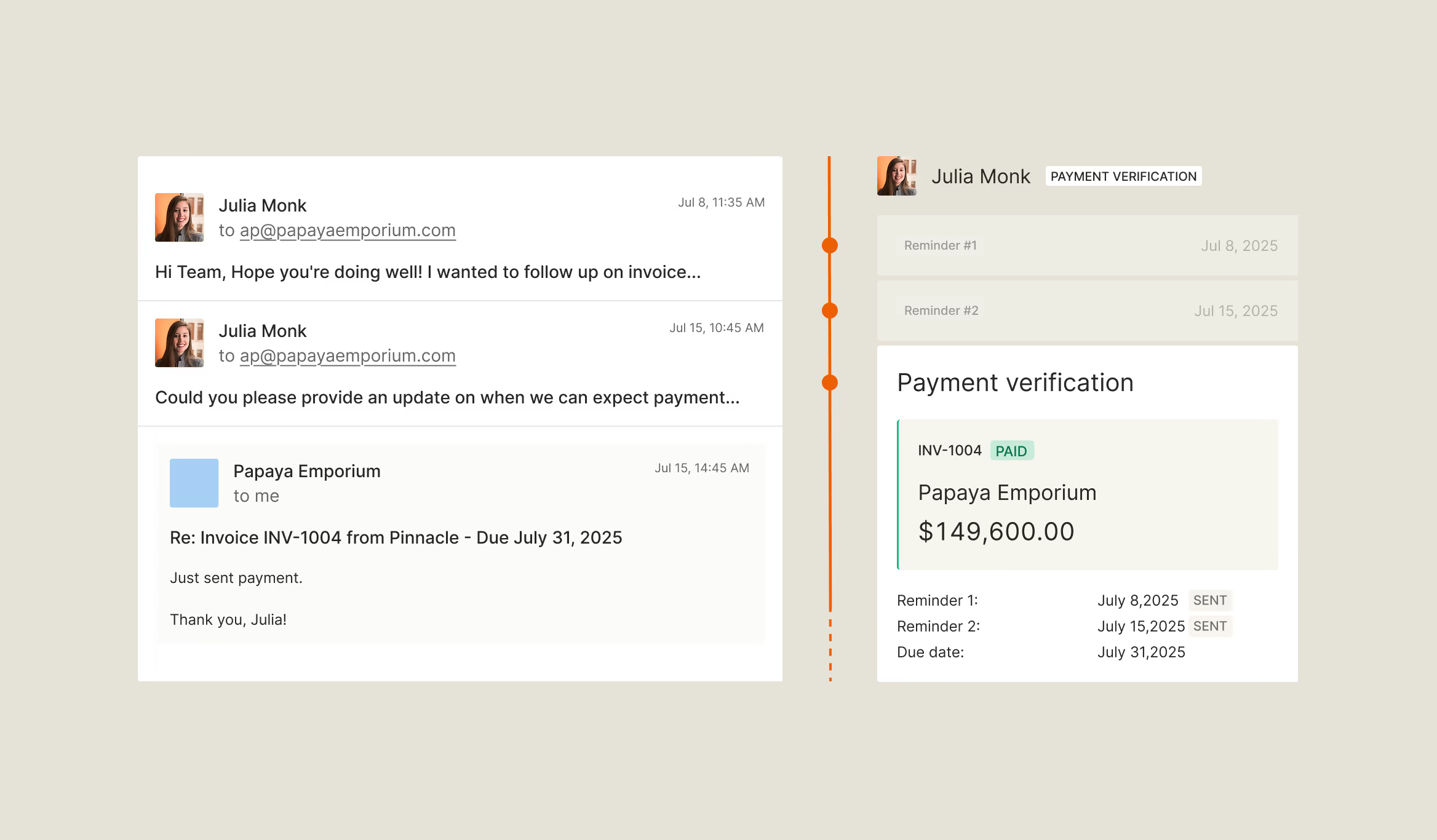5 AI Use Cases in Finance That Are Actually Working (With a Deep Dive on A/R and Monk)

The hype cycle is over. AI isn’t the future of finance—it’s the present, especially in workflows buried in unstructured data, coordination overhead, and timing sensitivity. Nowhere is the value more immediate than in accounts receivable, where platforms like Monk automate collections, cash application, and real-time forecasting. This guide explores 5 high-leverage, real-world use cases where AI is not just adding value—it’s becoming the default.
AI Use Case #1: Accounts Receivable Automation (Monk)
Why A/R?
Because it's where the business gets paid. The cash you earn already exists—it’s trapped in workflows. That makes A/R a P0 cashflow lever.
What goes wrong without AI:
- Invoices are late or inaccurate
- Customer replies go unlogged or unread
- Payment intent is hidden in vague emails
- Disputes stall collections without SLAs
- Stripe/ACH payments aren’t applied correctly
- DSO creeps up, then becomes a permanent liability
How Monk applies AI:
Function
Manual Workflow
Monk AI Workflow
Customer communication
Gmail threads + follow-up spreadsheets
LLM reads replies, extracts PTPs, logs intent, flags risk
Collections emails
Static templates sent by A/R team
AI-personalized sequences based on behavior + invoice age
Payment matching
CSV reconciliation + guesswork
AI matches Stripe, ACH, Plaid payments to correct invoice
Forecasting
DSO-based Excel models
Behavioral forecasting based on live signals
Disputes
Ad hoc back-and-forth with sales/ops
AI-classified, routed, and tracked with SLAs
Quantified impact seen with Monk:
- Up to 90% of collections automated
- DSO reductions of 20–40% in 60–90 days
- Thousands of A/R emails auto-classified weekly
- $1M+ unlocked in working capital for mid-market companies
- Fewer finance headcount needed for same collections velocity
“Every other part of the business gets real-time visibility and automation. A/R was 10 years behind—until we turned on Monk.” – Controller, Series C SaaS
AI Use Case #2: Financial Forecasting + Scenario Planning
Most forecasts are glorified guesses:
- Static models that assume constant DSO, churn, hiring pace
- High sensitivity to manual errors
- No input from actual customer or transaction behavior
How AI improves it:
- Live ingestion from QuickBooks, Stripe, CRM, HRIS, Monk
- Rolling 13-week cashflow models that adapt to events
- Predictive drivers based on seasonality, pipeline risk, cash-in trends
- “What if” scenario planning with embedded GPT agents (e.g., “what if DSO rises 15%?”)
Why this compounds when paired with Monk:
Instead of forecasting based on assumed 45-day DSO, you forecast on real-time customer behavior. That lets finance teams shift from being reactive to predictive.
AI Use Case #3: Contract, PO, and Invoice Parsing
B2B finance lives in documents: MSAs, POs, invoices, amendments, SOWs, remittance emails. Historically:
- Parsing was brittle (regex, OCR)
- Validation required manual checks
- Context got lost in translation across systems
AI improvements:
- LLMs parse PDFs, Excel, HTML emails with embedded terms
- Normalize vendor-specific invoice formats
- Cross-validate terms: “Does invoice net-45 match contract net-30?”
- Detect missing or inconsistent data before invoices go out
Where Monk uses this:
- Reads inbound remittance attachments to match partial payments
- Validates outbound invoices against stored payment terms
- Flags mismatches (PO errors, wrong tax ID, incorrect recipient)
This eliminates “we can’t pay this” as a delay excuse—and tightens cash-in velocity.
AI Use Case #4: Expense Monitoring + Anomaly Detection
Corporate spend is increasingly decentralized (cards, SaaS, contractors), and compliance overhead is massive. Finance teams waste hours/month scanning:
- Duplicate transactions
- Out-of-policy charges
- Fraudulent vendor behavior
- Unusual expense spikes
AI-driven anomaly detection platforms now:
- Analyze historical spend by category, vendor, department
- Auto-classify based on context and metadata
- Flag unusual behavior: “Why did marketing spend 4x usual on Zoom?”
- Provide smart approvals and pre-approvals based on learning
Real-world examples:
- Ramp and Brex embedding GPT-based explainability into T&E spend
- Custom GPTs for tagging GL entries + generating audit notes
- Monthly close times reduced by 40–60% through proactive review
AI Use Case #5: Bank Reconciliation + Cash Matching
Historically a black hole of error-prone work:
- Bank feeds + ERP don’t always align
- Transaction memos are unclear or misapplied
- Partial payments, timing differences, ACH batches create confusion
What AI fixes:
- Reads bank feeds, Stripe/ACH deposits, and maps to open receivables
- Matches fuzzy text memos, partial amounts, and payment windows
- Clusters transactions for mass application (“bulk payment from customer X”)
- Self-improves: the more you reconcile, the faster it gets
Monk does this with collections reconciliation specifically:
- Auto-matches 90–95% of payments to the correct invoice
- Routes the 5–10% edge cases with full suggested matches
- Cuts month-end close time by days, especially in high-volume environments
Common Traits of High-ROI AI Use Cases in Finance
Trait
Why It Matters
High-volume, high-frequency data
Reduces manual load significantly
Semi-structured inputs
AI can normalize PDFs, emails, spreadsheets
Downstream financial impact
Affects cashflow, compliance, audit, or margin
Rule-based + exception logic
AI can handle 80–90% automatically, flag the rest
Unowned workflow
Cross-team friction (Sales ↔ Finance ↔ Ops)
Final Word
Finance was late to AI—but now it’s leading in applied ROI.
The best finance teams in 2025 aren’t building dashboards.
They’re building automation flywheels, starting with A/R.
Monk leads that movement—not by showing you more metrics, but by getting you paid, faster, with less effort and fewer errors.
If your revenue already exists, Monk ensures you collect it.
That’s the simplest, fastest ROI AI can deliver.
.png)
.avif)

